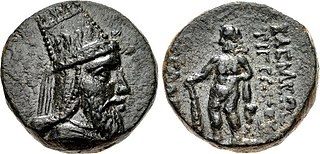Related Research Articles

The Nabataeans or Nabateans were an ancient Arab people who inhabited northern Arabia and the southern Levant. Their settlements—most prominently the assumed capital city of Raqmu —gave the name Nabatene to the Arabian borderland that stretched from the Euphrates to the Red Sea.

Antipater I the Idumaean was the founder of the Herodian Dynasty and father of Herod the Great. According to Josephus, he was the son of Antipas and had formerly held that name.

Herod Archelaus was the ethnarch of Samaria, Judea, and Idumea, including the cities Caesarea and Jaffa, for nine years. He was the son of Herod the Great and Malthace the Samaritan, brother of Herod Antipas, and half-brother of Herod II. Archelaus came to power after the death of his father Herod the Great in 4 BC, and ruled over one-half of the territorial dominion of his father. Archelaus was removed by the Roman emperor Augustus when Judaea province was formed under direct Roman rule, at the time of the Census of Quirinius.

Aretas IV Philopatris was the King of the Nabataeans from roughly 9 BC to 40 AD.

Aristobulus V of Chalcis was a son of Herod of Chalcis and his first wife Mariamne. Herod of Chalcis, ruler of Chalcis in Iturea, was a grandson of Herod the Great through his father, Aristobulus IV. Mariamne was a granddaughter of Herod the Great through her mother, Olympias; hence Aristobulus was a great-grandson of Herod the Great on both sides of his family.

Tigranes VI, also known as Tigran VI or by his Roman name Gaius Julius Tigranes was a Herodian prince and served as a Roman client king of Armenia in the 1st century.

Tigranes V, also known as Tigran V was a Herodian prince who ruled as a Roman client king of Armenia from 6 AD to 12 AD.
Phasael, was a prince from the Herodian Dynasty of Judea.

Antipater II was Herod the Great's first-born son, his only child by his first wife Doris. He was named after his paternal grandfather Antipater the Idumaean. He and his mother were exiled after Herod divorced her between 43 BC and 40 BC to marry Mariamne I. However, he was recalled following Mariamne's fall in 29 BC and in 13 BC Herod made him his first heir in his will. He retained this position even when Alexander and Aristobulus rose in the royal succession in 12 BC, and even became exclusive successor to the throne after their execution in 7 BC.
Herod II was the son of Herod the Great and Mariamne II, the daughter of Simon Boethus the High Priest, and the first husband of Herodias, daughter of Aristobulus IV and his wife Berenice. For a brief period he was his father's heir apparent, but Herod I removed him from succession in his will. Some writers call him Herod Philip I, as the Gospel of Matthew and Gospel of Mark state that Herodias was married to a "Philip". Because he was the grandson of Simon Boethus, he is sometimes also called Herod Boethus, but there is no evidence he was actually thus called during his lifetime. (Josephus states this Mariamne II, daughter of simon boethus, had a son named Herod who was removed from his will on his death bed and also divorced this mariamne for plots against Agrippa, this family of simon boethus is the same boethus jesus speaks of, Magdalene, Martha, Lazarus and simon. Magdalene is the mariamne II, mother of Herod II!) Acts 12:11 " peter knocked on the door of the gate of the house of mary, mother of john" also points out she is high class gated community. Herodias married this Herod II, salome married Philip. It all can be proven in Josephus Antiquities chapter V:4. Editor added "philip" but it states clearly herod the great's son with mariamne, daughter of olympias and joseph ben joseph who was brother to herod the king!

Philip the Tetrarch, sometimes called Herod Philip II by modern writers, son of Herod the Great and his fifth wife, Cleopatra of Jerusalem, ruled over the northeast part of his father's kingdom between 4 BCE and 34 CE. He was a half-brother of Herod Antipas and Herod Archelaus and should not be confused with Herod II, whom some writers call Herod Philip I.
Gaius Julius Alexander II was a Herodian Prince who lived in the 1st century and 2nd century in the Roman Empire.
Gaius Julius Agrippa was a Cilician Prince and the first-born son of King Gaius Julius Alexander and Queen Julia Iotapa of Cetis. He had two younger siblings: a brother called Gaius Julius Alexander Berenicianus and a sister called Julia Iotapa.
Gaius Julius Alexander Berenicianus was a Cilician Prince and second-born son to King Gaius Julius Alexander and Queen Julia Iotapa of Cetis. His eldest brother was Gaius Julius Agrippa and his younger sister was Julia Iotapa.
Lucius Julius Gainius Fabius Agrippa, also known as Lucius Julius Agrippa, was a considerably wealthy man who descended from royalty. He lived in the second half of the 1st century and early part of the 2nd century AD in the Roman Empire.

Alexander, son of Herod was born about 35 BC; died about 7 BC. His mother was the Hasmonean princess Mariamne.
Alexander II, also known by his Roman name Gaius Julius Alexander was a Herodian prince.

Hadad-yith'i was governor of Guzana and Sikani in northern Syria. A client king or vassal of the Neo-Assyrian Empire, he was the son of Sassu-nuri, who also served as governor before him. Knowledge of Hadad-yith'i's rule comes largely from the statue and its inscription found at the Tell Fekheriye. Known as the Hadad-yith'i bilingual inscription, as it is written in both Old Aramaic and Akkadian, its discovery, decipherment and study contributes significantly to cultural and linguistic understandings of the region.
Phasaelis, also spelled Phaisael was a princess of Nabatea, daughter of King Aretas IV Philopatris and the first wife of Herod Antipas, ruler of Galilee and Perea.
Phasael is the English form of an ancient Semitic, probably mainly Nabataean name used for both men and women. Fasayil is a modern Arabic version, Petza'el a Modern Hebrew one.
References
- 1 2 3 4 5 6 7 8 9 10 11 Norris, Jérôme (26 April 2017). "A woman's Hismaic inscription from the Wādī Ramm desert: AMJ 2/J.14202 (Amman Museum)". Arabian Archaeology and Epigraphy. 28 (1): 90–109. doi:10.1111/aae.12086 . Retrieved 24 April 2024.
- ↑ "Phasaelus". The Zondervan Pictorial Encyclopedia of the Bible. 26 April 2017. pp. 90–109. Retrieved 24 April 2024– via BibleGateway.com.
- ↑ Shemaryah or Shemaryahu at BibleHub.com. Accessed 24 Apr 2024.